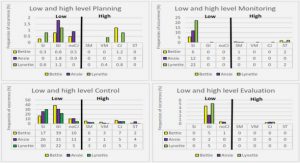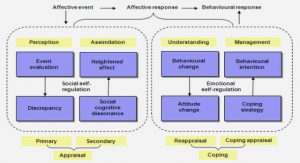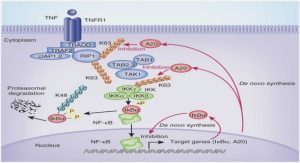Get Complete Project Material File(s) Now! »
Geometrical Theory of Diffraction (GTD)
The theory state that “the incident ray excites a fictitious cone of diffracted rays; all subtend the same angle with respect to the edge as that subtended by the incident ray”. This method comes as an extension of GO method to account the non-zero fields in the shadow region, as shown in figure (2).
Fig (2): Diffracted ray cone from a line of discontinuity
The GTD have some drawbacks
1. The observation point must be laid within the fictitious Keller cone, otherwise yields precisely zero.
2. The theory predicts infinite fields when the observation point is pierced by infinity of rays, such as point’s lies on the axis of body of revolution (BOR).
3. It takes into the account the diffracted fields, such as the fields in the shadow region.
4. The GTD is used to compute the scattered fields well away from the specular direction as well as the polarization effects are inherently built-in.
Method of Moments (MoM)
Method of Moment (MoM) technique is one of the well known methods that are used in electromagnetic scattering problems. This technique is based on reducing the operator equations to a system of linier equations that is written in matrix form.
The features of this method can be summarized in the following
1. It has a frequency domain RCS prediction technique.
2. It takes to the account the entire electromagnetic phenomenon and also the polarization effects for excite field.
3. It is an integral equation based technique.
One of the advantages of using this method is that the results are very accurate because the equations that his method use is essentially exact and MoM provides a direct numerical solution of these equations. Another advantage is that in practice, it is applicable to geometrically complex scatter [7].
Finite Difference – Time Domain (FD – TD)
This method is a popular computational electrodynamics modelling technique. It is considered easy to understand and easy to implement in software. Since it is a time-domain method, solutions can cover a wide frequency range with a single simulation run.
The FDTD method belongs in the general class of grid-based differential time-domain numerical modelling methods. The time-dependent Maxwell’s equations (in partial differential form) are discredited using central-difference approximations to the space and time partial derivatives. The resulting finite-difference equations are solved in either software or hardware in a leapfrog manner: the electric field vector components in a volume of space are solved at a given instant in time; then the magnetic field vector components in the same spatial volume are solved at the next instant in time; and the process is repeated over and over again until the desired transient or steady-state electromagnetic field behaviour is fully evolved.
This method take accounts the polarization effects and the diffracted fields. In addition, the method is a differential equation technique (as mention above).
Effective Partial Differential Equation Algorithm (EPDEA)
This method is used to solve the scattering problems by three dimensional body of revolution using Partial Differential Equation (PDE) technique. This technique is employed in conjunction with a radiation boundary condition applied in the Fresnel region of the scatterer. Based on an asymptotic expansion derived by Wilcox, the radiation boundary condition is used to truncate the PDE mesh [4]. More about this method will be discussed later in this thesis.
Characteristics Basis Function Method (CBFM)
This method have been developed in conjunction with the Fast Fourier Transform (FFT) for matrix generation to improve the efficiency of the Method of Moment when analysing electromagnetic scattering from large Perfect Electrically Conducting (PEC) bodies of revolution. The CBFs are high-level basis functions comprising conventional sub domain bases, and their use leads to a reduced matrix which can be solved by using a direct method. By using this technique, one can get a good advantage that the computational time and memory requirement can be significantly reduced for large BOR problems [5].
The second part, reduction of RCS (RRCS), the information in this technique is limited and it is difficult to obtain as well but due to the development in the semiconductors, the RRCS is taken place in the radar systems [6]. There are four basic techniques for reducing the RCS; they are shaping, radar absorbing materials, passive cancellation and finally the active cancellation. Of course each technique of these has its advantage and disadvantage.
With purpose shaping, the shape of the target’s reflecting surfaces is designed such that they reflect energy away from the source. The aim is usually to create a “cone-of-silence” about the target’s direction of motion. Due to the energy reflection, this method is defeated by using passive radars. With radar absorbed material (RAM), it can be used in the original construction, or as an addition to highly reflective surfaces. For the passive cancellation, its concept is to generate an echo source whose amplitude and phase can be adjusted to cancel any other echo sources, it calls impedance loading some times. The fourth technique; active cancellation; the target generates a radar signal equal in intensity but opposite in phase to the predicted reflection of an incident radar signal (similarly to noise cancelling ear phones). This creates destructive interference between the reflected and generated signals, resulting in reduced RCS. To incorporate active cancellation techniques, the precise characteristics of the waveform and angle of arrival of the illuminating radar signal must be known, since they define the nature of generated energy required for cancellation. Except against simple or low frequency radar systems, the implementation of active cancellation techniques is extremely difficult due to the complex processing requirements and the difficulty of predicting the exact nature of the reflected radar signal over a broad aspect of an aircraft, missile or other target. This technique is also called active loading.
As we know, bodies of revolutions objects are used in these problems to simplify the calculations, due to the symmetrical property so the surface current can be explained in some small terms that helps in reducing the memory usage and the computation time. In the same way, complex bodies can be treated like bodies of revolution in their calculations.
This body of revolution (BOR) approach has been applied to several numerical methods such as MoM, EPDEA and CBFM. In our work, we are going to use the Efficient Partial Differential Equation Algorithm EPDEA to calculate the surface current density Jθ .
Radar Cross Section (RCS):
Radar Cross Section (RCS);σ is the unit of measure of how detectable an object is with radar. For example a stealth aircraft (which is designed to be undetectable) will have design features that give it a low RCS, as opposed to a passenger airliner that will have a high RCS. An object’s RCS depends on its size, reflectivity of its surface, and the directivity of the radar reflection caused by the object’s geometric shape. So in other expression, RCS can be written as:
Radar Cross Section (RCS) = Geometric Cross Section × Reflectivity × Directivity
Table of contents :
CHAPTER 1: INTRODUCTION
1.1 INTRODUCTION
1.2.1 RADAR CROSS SECTION (RCS):
1.2.2 RADAR RANGE EQUATION (RRE)
1.2.3 SCATTERING REGIMES
1.3 LITERATURE SURVEY
1.3.1 SCATTERING AND RADIATION FROM PERFECTLY CONDUCTING BODIES
1.3.2 SCATTERING AND RADIATION FROM IMPERFECTLY CONDUCTING BODIES
1.3.3 RADAR CROSS SECTION RCS MEASUREMENTS
CHAPTER 2: SCATERING FROM CONDUCTING BODIES OF REVOLUTION
2.1 INTRODUCTION
2.2 FORMULATION OF SCATTERING PROBLEM
2.3 MOMENT SOLUTION
2.4 EVALUATION OF DRIVING VECTOR AND FAR FIELD COMPONENTS
2.5 RADAR CROSS SECTION (RCS)
2.6 EFFICIENT PARTIAL DIFFERENTIAL EQUATION ALGORITHM (EPDEA):
2.6.1 FORMULATION OF BODY OF REVOLUTION PROBLEM
CHAPTER 3: RESULTS & DISCUSSIONS
3. RESULTS AND DISCUSSION
TABLE 3.1: THE GENERALIZED ADMITTANCE MATRIX [Y]
TABLE 3.2: REAL AND IMAGINARY PARTS AND MAGNITUDE OF THE Ρ AND Ф DIRECTED CURRENT. Ρ IS THE ARC LENGTH
TABLE 3.3: THE RADAR CROSS SECTION () WITH RESPECT TO Ѳ
TABLE 3.4: REAL AND IMAGINARY PARTS AND MAGNITUDE OF THE Ρ AND Ф DIRECTED CURRENTS. Ρ IS THE ARC LENGTH
TABLE 3.5: THE RADAR CROSS SECTION () WITH RESPECT TO Ѳ
TABEL 3.6: EXCITED CURRENT COMPONENTS
TABLE 3.7: THE NORMALIZED POWER GAIN PATTERN
REFERENCES
APPENDIX
A.1 THE MATHEMATICA WORK TO SOLVE THE EQUATIONS)
A.2 SPHERICAL COORDINATES (:,,φθr)
A.3 MAXWELL’S EQUATIONS




